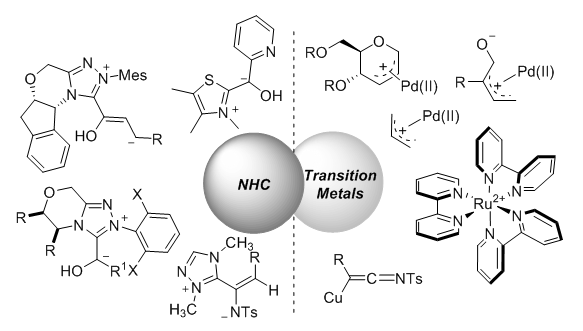摘要/Abstract

近年来,氮杂环卡宾作为有机小分子催化剂在共催化领域取得了飞速发展,氮杂环卡宾通过与Lewis酸、Brønsted酸、Brønsted碱、氢键等不同催化模式相结合,可以有效提升惰性底物的活性和催化体系的立体控制能力,该策略已经成为复杂手性分子骨架合成的重要工具.相对而言,由于氮杂环卡宾与过渡金属的强配位能力,其与过渡金属共催化反应依旧是氮杂环卡宾在共催化领域中长期存在的挑战性工作.目前,氮杂环卡宾在与钯、铜和钌的共催化反应中取得了重要进展,通过配体和反应体系中碱性强弱的调控,可以有效实现氮杂环卡宾与过渡金属配位的可控调节,避免催化剂失活的同时提升反应体系催化活性.这一策略已经被成功用于一些活性分子骨架构建.本文将对该领域中的研究进展进行介绍.
关键词: 氮杂环卡宾, 过渡金属催化, 共催化, 不对称催化, 小分子催化
Recently, N-heterocyclic carbene (NHC) catalysis has achieved significant achievement in the field of cooperative catalysis. With the combination of other established catalysis modes (e.g., Lewis acid, Brønsted acid/base, hydrogen-bond donor), great improvement has been made in the enhancement of reactivity and stereoselectivity, and this strategy has emerged as a powerful instrument in organic synthesis to construct complex molecules. However, owing to the strong propensity of NHCs to bind to transition metals, the development of cooperative catalysis of NHCs and transition metals remains a longstanding and challenging work. At present, some important progress has been made in the combination of NHCs with palladium, copper and ruthenium, and the coordination of NHCs and transition metals can be controlled by the modulation of ligand and alkalinity in reaction system, which not only avoiding the deactivation of the catalysts, but also improving the reaction activity efficiently. This strategy has also been used in the asymmetric construction of bioactive molecular scaffolds. In this perspective, the achievements on NHC and transition metals cooperative catalysis will be discussed.
Key words: N-heterocyclic carbene, transition-metal catalysis, cooperative catalysis, asymmetric catalysis, organocatalysis
PDF全文下载地址:
点我下载PDF
